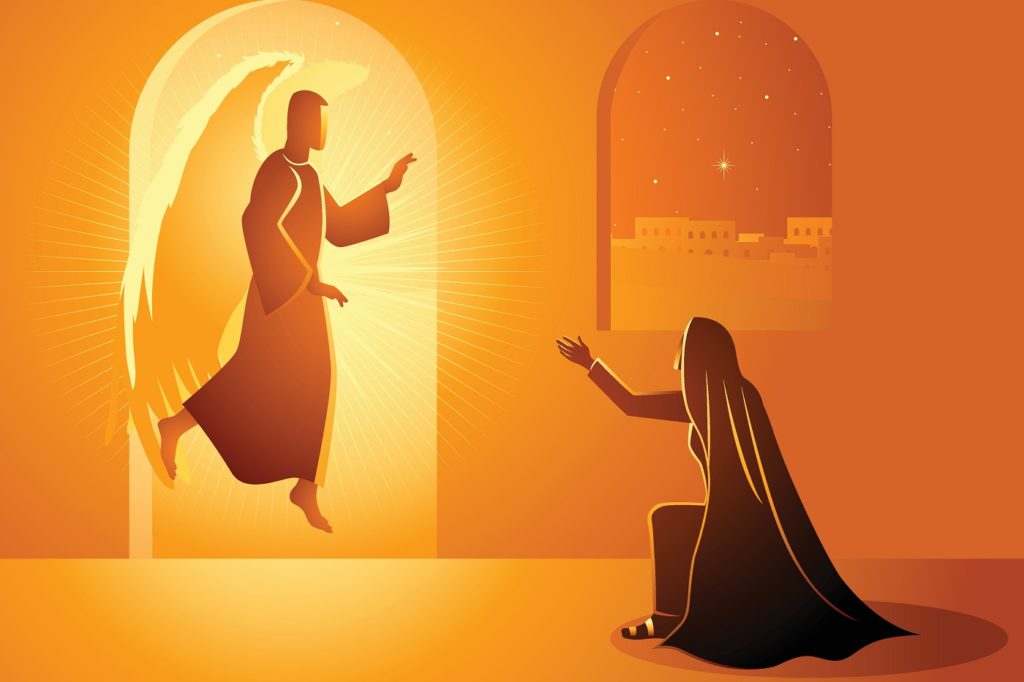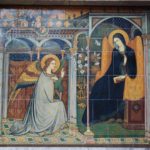As the pregnancy of Advent deepens, darkens, and sharpens to its explosive point of nativity, an instinctive silence begins to turn one’s attention inward. A groping for incarnation takes place, a probing for features in the still-shrouded face, a search for personal resolution to the long, dark waiting of the season. Who, exactly, am I waiting for? What am I invited to? Unlikely though it may seem, the Magnificat, “Mary’s Song” recorded in Luke’s Gospel, offers such a unique invitation, a personal gift from Jesus, preserved in the scriptures by the Holy Spirit for millennia. This ancient canticle demonstrates why Jesus’s mother is a special gift and invitation from him to the whole church.
When I selected the Magnificat for my next radio show study series, I was wading into unfamiliar territory. Mary is a familiar friend to most Catholics, but as a convert from Protestantism, I was apathetic toward Jesus’s mother. As I began to research for the series, however, I found my heart slowly changing as I made a startling discovery: Mary’s Magnificat reveals her deep love of Scripture. When we examine the Magnificat’s scriptural beauty, we learn not only how deeply Mary herself was steeped in God’s word, but also how to sink more deeply into the Word as well, collectively as the Church and as individual Christians.
The Magnificat As the Song of the Church
Start your day with Public Discourse
Sign up and get our daily essays sent straight to your inbox.Mary’s joyful response to the revelation of the Incarnation, recorded in Luke’s Gospel, is the heartbeat of the liturgical and devotional life of the Church, revealed in both the Rosary (in the Mysteries of the Annunciation and Visitation) and Daily Office at Vespers. Such daily prayers are truly interdenominational, as they consist almost entirely of Holy Scripture. In the ancient Jewish tradition of psalmody, the Magnificat is the musical bridge between the Covenants. As the last of the Old Testament psalms (songs), and the first of the New, the Magnificat recalls the ancient promises, celebrates Mary’s role in their fulfillment, and brings them forward for the church in newness of life.
While the Magnificat’s origins have been the subject of academic debate, it is thought to be the oldest Marian hymn. But Mary approaches us as a mother, not an academic. She speaks in her own words, and when she does, a deep love of Scripture and a unique invitation to it emerge. The Magnificat is so called for the first word, magnify, in Latin: “My soul magnifies the Lord.” In its stanzas, the Magnificat features a parallelism characteristic of Hebrew poetry: “My soul magnifies the Lord” mirrors “my spirit rejoices in God my Savior.”
But the real gift in Mary’s Magnificat is that it is drawn from the Old Testament: the Torah, the Song of Hannah, the psalms all shine forth as witnesses to Mary’s love for the Jewish scriptures. As a faithful Jewish woman, Mary would have kept the fixed-hour prayer practice of her people, consisting of such passages, three times a day.
But the real gift in Mary’s Magnificat is that it is drawn from the Old Testament: the Torah, the Song of Hannah, the psalms all shine forth as witnesses to Mary’s love for the Jewish scriptures. As a faithful Jewish woman, Mary would have kept the fixed-hour prayer practice of her people, consisting of such passages, three times a day. When Mary praises God for all he is doing through her, what pours forth and runs up the hillsides of history in song is Scripture. Through the Magnificat, the Holy Spirit reveals Mary’s deep acclimation in and love of Scripture.
In fact, no one has ever loved the Word the way Mary loves the Word. The Incarnation is an unrepeatable mystery, after all. And of course, the Word of God is a person, not a book. Yet the Catechism teaches that the “one table” of the Lord is both the scriptures and the Eucharist (CCC 103). Therein is Mary’s gift and invitation through her Magnificat: to love the Word with her, like her, so that it becomes incarnate in us, too, and we can offer it back to a dark world as light, life, and hope.
The Magnificat as Invitation to Pray with Scripture
But Mary does not offer the Word to the world by preaching, or speaking, or writing, as worthy as such endeavors are. Pope Emeritus Benedict XVI called Mary the model of prayer. Her longing for the Messiah of her people, in both heart and practice, was strong enough that the Holy Spirit could give him flesh in her. Her oneness with him, her prayer, endured intimately enough to receive his torn, ripped, battered flesh back again from the cross. Yet God did not search the annals of history for the one woman who was capable of receiving the Incarnation; no woman fierce enough to mother such a Son could have ever existed, had God not made one for himself. Mary was (and is) not as she is often imagined—some quiet, shy, naïve teenager who stumbled into the virgin birth as though she fell into a rain puddle. She was made for Magnificat, for Jesus.
Perhaps that is why Blessed Anne Catherine Emmerich—whose visions were used, in part, to make the movie The Passion of the Christ—said she saw Mary in her chamber praying specifically for the Messiah when the Angel Gabriel appeared to her. God made Mary for that purpose; he placed that ancient yearning within her; he inspired her to pray for its fulfillment; he answered her prayer with her. Even now, Mary retains her utter uniqueness because she alone can be at the same time mother and disciple of the Lord. But Mary’s Magnificat is an invitation from the Holy Spirit to all of us to pray the way she prays, to love the Word the way she loves the Word. Through the scriptures, we are pulled up into the soaring communion of love that she knows, so that we are so fully received as to be incarnated and offered into the human relationships and circumstances of our world.
This word of God through the scriptures is offered daily in the readings of the Church. In an address in St. Peter’s Square, Pope Francis described the ability to hear the voice of God speaking directly to one’s individual relationships and circumstances, lifting up Our Lady as an example. He calls Mary the “mother of listening.” As a model of prayer, Mary does not speak first; she listens. In his address, Pope Francis follows Mary through her personal practice of attentive listening, illustrated through the Annunciation and her Magnificat, outlining how delicately and effectively she illustrates the traditional steps of lectio divina, or sacred reading. The ancient steps of lectio divina are perhaps more accessible through the LOVE the Word method that Mary models and invites us to practice every day:
L | Listen What gave rise to Mary’s act of going to visit her relative Elizabeth? A word of God’s angel. The word that I hear and read today is a gift from God in answer to my prayers. So I read the passage slowly. I savor each word as I read, possibly emphasizing each word in turn.
O | Observe Remembering that I am in the presence of the Holy Spirit, I observe the events of my life with him, just as Mary pondered. Where does this passage speak to the circumstances, relationships, habits, concerns, and problems of the past day? To what word, phrase, or idea is my attention drawn? How is the Holy Spirit guiding and encouraging me today through this passage?
V | Verbalize As I linger with the Holy Spirit over all that has surfaced in my heart and mind through his word, I verbalize what I think he is saying to me, as Mary expressed the Magnificat and the Holy Spirit preserved it for us in writing. I talk to him freely about my thoughts and feelings. I write it all down as best I understand it and ask him to confirm or deny what I believe he is saying. I watch to see how he answers by continuing to observe the events of this day and week.
E | Entrust Once I have decided on some action with his help and in his presence, I am often overwhelmed by the tenderness, patience, mercy, forgiveness, and generosity of God. I resist words now. As I remain silent and simply rest in him, I entrust him with every outcome, just as Mary did: “May it be done to me according to your word.”
Becoming Magnificat
Those who study the Magnificat and pray with Mary learn to approach her as an icon of every soul seeking its relationship to God. Jesus offers them the gift of experiencing an incarnational relationship with the Holy Spirit, through the scriptures, that is demonstrated through her song. The Magnificat reveals that Mary does not merely speak or say what became the song of the Church. Mary does not sing the Magnificat. She does not magnify the Lord simply by her words.
Mary is the Magnificat. Mary is the song.
Offered daily through the liturgical prayer of the Church, the Magnificat invites every Christian, through Jesus, to see the Holy Spirit through the rare expression of the woman from whose flesh our Savior took his own. The Magnificat is Mary in her own words. It inspires study and imitation of the scriptures by presenting Mary as a gift and invitation, a mother of prayer and listening for all. Receiving this Advent gift, sharing in Mary’s love for praying with Scripture, draws from each soul the song for which God made him; the full, flowering purpose for which he was created; the song with which he, too, “magnifies the Lord.” He becomes a magnificat.
Study and prayer with Mary’s Magnificat shows us that every human being has a song to sing, but perhaps more importantly, that he is the song.














